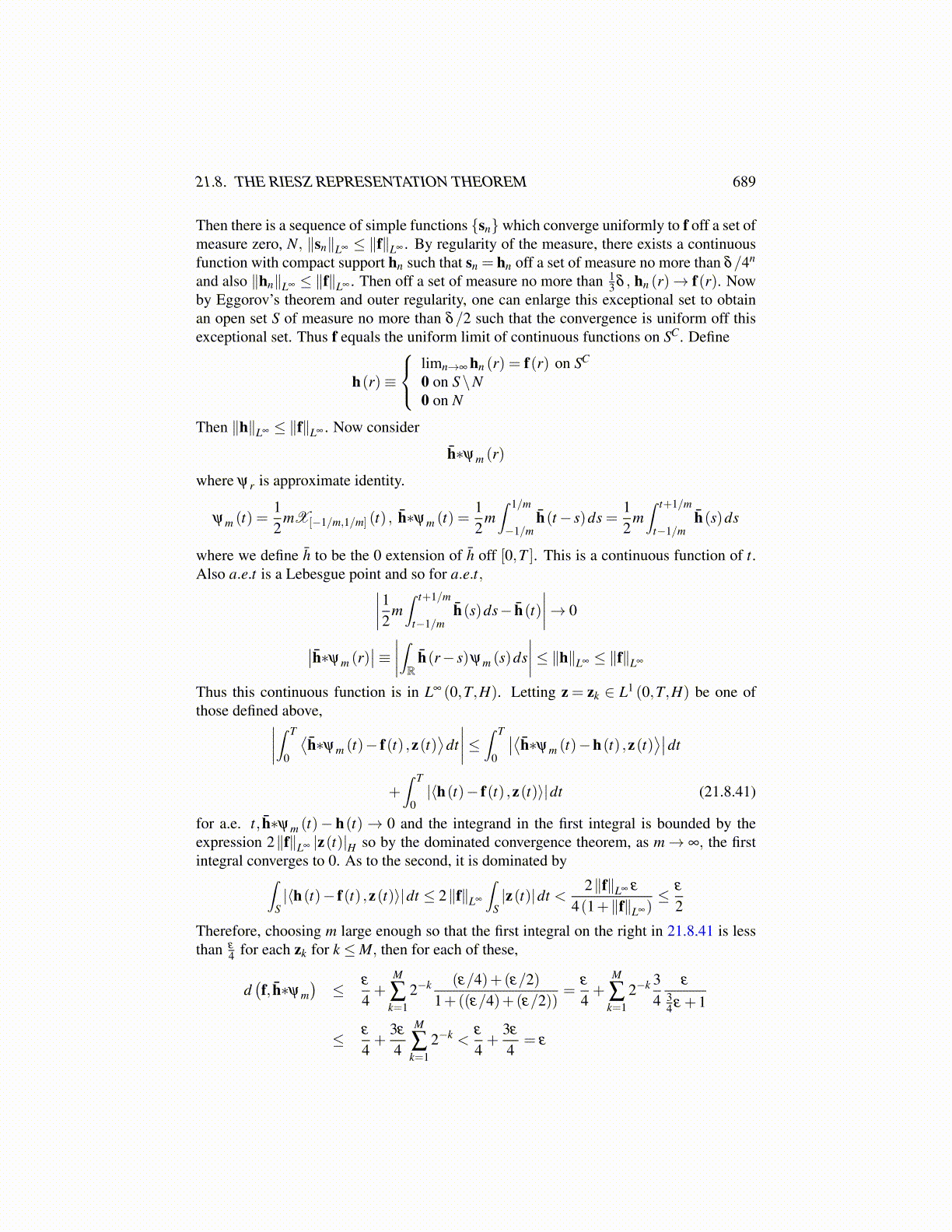
21.8. THE RIESZ REPRESENTATION THEOREM 689
Then there is a sequence of simple functions {sn}which converge uniformly to f off a set ofmeasure zero, N, ∥sn∥L∞ ≤ ∥f∥L∞ . By regularity of the measure, there exists a continuousfunction with compact support hn such that sn = hn off a set of measure no more than δ/4n
and also ∥hn∥L∞ ≤ ∥f∥L∞ . Then off a set of measure no more than 13 δ , hn (r)→ f(r). Now
by Eggorov’s theorem and outer regularity, one can enlarge this exceptional set to obtainan open set S of measure no more than δ/2 such that the convergence is uniform off thisexceptional set. Thus f equals the uniform limit of continuous functions on SC. Define
h(r)≡
limn→∞ hn (r) = f(r) on SC
0 on S\N0 on N
Then ∥h∥L∞ ≤ ∥f∥L∞ . Now consider
h̄∗ψm (r)
where ψr is approximate identity.
ψm (t) =12
mX[−1/m,1/m] (t) , h̄∗ψm (t) =12
m∫ 1/m
−1/mh̄(t− s)ds =
12
m∫ t+1/m
t−1/mh̄(s)ds
where we define h̄ to be the 0 extension of h̄ off [0,T ]. This is a continuous function of t.Also a.e.t is a Lebesgue point and so for a.e.t,∣∣∣∣12m
∫ t+1/m
t−1/mh̄(s)ds− h̄(t)
∣∣∣∣→ 0
∣∣h̄∗ψm (r)∣∣≡ ∣∣∣∣∫R h̄(r− s)ψm (s)ds
∣∣∣∣≤ ∥h∥L∞ ≤ ∥f∥L∞
Thus this continuous function is in L∞ (0,T,H). Letting z = zk ∈ L1 (0,T,H) be one ofthose defined above,∣∣∣∣∫ T
0
⟨h̄∗ψm (t)− f(t) ,z(t)
⟩dt∣∣∣∣≤ ∫ T
0
∣∣⟨h̄∗ψm (t)−h(t) ,z(t)⟩∣∣dt
+∫ T
0|⟨h(t)− f(t) ,z(t)⟩|dt (21.8.41)
for a.e. t, h̄∗ψm (t)− h(t)→ 0 and the integrand in the first integral is bounded by theexpression 2∥f∥L∞ |z(t)|H so by the dominated convergence theorem, as m→ ∞, the firstintegral converges to 0. As to the second, it is dominated by∫
S|⟨h(t)− f(t) ,z(t)⟩|dt ≤ 2∥f∥L∞
∫S|z(t)|dt <
2∥f∥L∞ ε
4(1+∥f∥L∞)≤ ε
2
Therefore, choosing m large enough so that the first integral on the right in 21.8.41 is lessthan ε
4 for each zk for k ≤M, then for each of these,
d(f, h̄∗ψm
)≤ ε
4+
M
∑k=1
2−k (ε/4)+(ε/2)1+((ε/4)+(ε/2))
=ε
4+
M
∑k=1
2−k 34
ε
34 ε +1
≤ ε
4+
3ε
4
M
∑k=1
2−k <ε
4+
3ε
4= ε